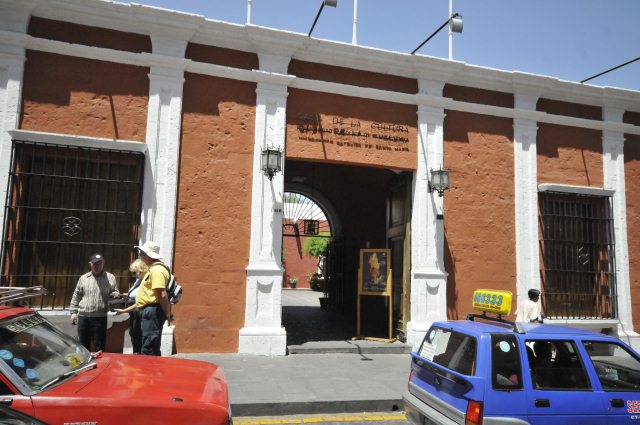Resting Place of Juanita

|
Museum of Andean Sanctuaries, Arequipa, Peru
The Museo Santuarios Andinos or Museum of Andean Sanctuaries is one of the many Arequipa attractions. Aside from the usual exhibits found in Peruvian museums such as artifacts from the Inca Empire, ceramics, textiles, and carving, the museum showcases the body of a young girl named Juanita, the Ice Maiden of Mount Ampato. The interesting story of Juanita and her preservation allowed researchers to gain an insight into the Inca culture.
 A last minute decision to photograph an erupting volcano gave anthropologist John Reinhard the find of his life – the Andes’ first frozen female mummy. Reinhard and his assistant found “Juanita” bundled in alpaca wool lying near a 20,700 foot high peak. The ice maiden is considered to be one of the world’s best preserved mummies. Juanita is said to be thirteen when she died by a blow on her head, a victim of ritual sacrifice of Inca priests. Found beside the girl were several ceremonial offerings. Juanita laid buried in the snow for about 550 years and was discovered in 1995 when the Sabancaya Volcano erupted, melting the ice on the peak of the volcano. Sadly when her body left its frozen resting place she rolled several hundred feet, the shawl covering her face wore through and damaged her face. One of the things to do in Arequipa is to visit the museum and to view the body of Juanita, now displayed in a glass freezer chamber in the museum.
Juanita's 500-year-old, well-preserved hand. Momia Juanita - "Mummy Juanita", better known in English as the "Ice Maiden," is the frozen body of an Inca girl. She lived to be approximately twelve to fourteen years old, and probably died sometime between 1450 and 1455. She was discovered on Mount Ampato (part of the Andes Cordillera) in southern Peru in 1995 by anthropologist Johan Reinhard and his Peruvian climbing partner Miguel Zarate. Also known as the Lady of Ampato and the Frozen Lady, Juanita has been on display in a museum in Arequipa, Peru, since 1996, except for one month in 1996 (see below) and when she was on tour in Japan in 1999. "Juanita" was remarkably well-preserved after five hundred years, making her one of the more important recent finds; indeed, this discovery was chosen by Time magazine, in 1995, as one of the world's top ten discoveries.

This picture hangs on the wall in the museum. It shows Juanita's hand with what looks like "white wax" around her fingers. This is tissue that had begun to leak out at the time of her freezing. When initially weighed in Arequipa, the bundle containing "Juanita" weighed over ninety pounds. When they tried to lift it on Ampato's summit, Reinhard and Zarate realized that the heavy body mass was probably due to the freezing. This preservation allowed biological tests to be run later on the lung, liver and muscle tissue. These offered new insights into Inca health and nutrition during the reign of the Sapa Inca Pachacuti.
 
The courtyard of the museum and Juanita's final resting place behind the doors at the far end of the second photograph
Discovery of
Juanita: In September 1995, during an ascent of Mt. Ampato (20,700 ft),
Reinhard and Miguel Zárate, one of his climbing companions from previous
expeditions, found inside the crater a bundle that had fallen from an Inca site
on the summit. Owing to melting caused by volcanic ash from the nearby erupting
volcano of Sabancaya, most of the Inca burial site had collapsed down a gully
that led into the crater. To their astonishment, the bundle turned out to
contain a remarkably well-preserved body of a young girl. In addition, they
found—strewn about the mountain slope down which the body had fallen— many items
that had been left as offerings to the Inca gods; these included statues and
food items. A couple of days later, the body and the objects were taken to
Arequipa. The body was initially kept in a special refrigerator at Catholic
University, where Chavez was Director of the Archaeology Department.
The body
caused a sensation in the scientific world due to its well-preserved condition.
Between May and June 1996, it was exhibited in the headquarters of the National
Geographic Society in Washington D.C., in a specially
acclimatized conservation/display unit engineered by the Carrier Corporation,
which donated two of these units to Catholic University. Cause of Death: Juanita was presumably killed as an offering to the mountain deity of Ampato, and her discovery, along with the other bodies of children found on the mountain, proves that Incas did perform human sacrifices on special occasions. She may have been specially selected for this role while a young girl, and may have had a pampered upbringing until she was taken to be sacrificed, when it was believed that her spirit would live on with the gods in the afterlife and she would herself have become deified and worshiped by local indigenous peoples.
  
The museum houses a display - a three dimensional model showing the mountains and volcanoes of the area. The area in these photographs shows the Colca Canyon - home to the Andean Condor

ALL IN ALL RIVETTING
.
|


